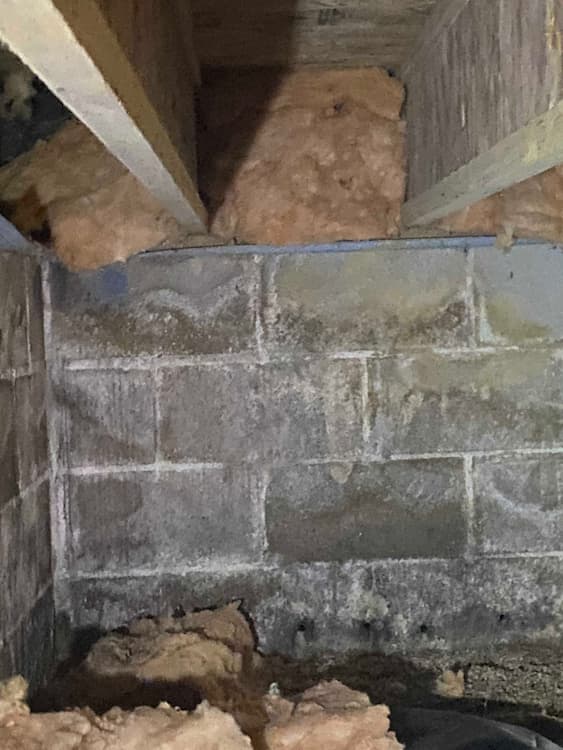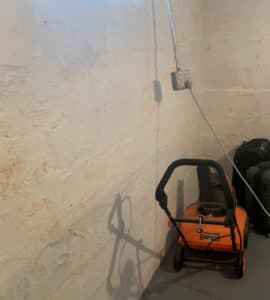
[et_pb_section fb_built="1" _builder_version="4.16" global_colors_info="{}"][et_pb_row _builder_version="4.16" background_size="initial" background_position="top_left" background_repeat="repeat" global_colors_info="{}"][et_pb_column type="4_4" _builder_version="4.16" custom_padding="|||" global_colors_info="{}" custom_padding__hover="|||"][et_pb_text _builder_version="4.16" background_size="initial" background_position="top_left" background_repeat="repeat" global_colors_info="{}"]Efflorescence is a fancy-sound word for an unattractive coating you may find on your foundation. The term is derived from the French word l' efflorescence, which means to bloom or blossom. But it’s not a delicately blooming flower or even a fancy pastry shaped like a blossom. It’s a coating on your foundation walls and an eyesore that irritates homeowners with wet basements.
Acculevel has been waterproofing homes throughout Indiana and the surrounding areas since our start in 1996. Founded by Andy Beery, we are a family-owned and operated company. We are insured and accredited by the Better Business Bureau1, and have provided whole-home solutions to over 30,000 homeowners.
In this FAQ, we’re going to explain efflorescence in detail. We’ll review what it looks like, what it says about your home, how to remove it, and how to prevent it from happening again.
For homeowners, efflorescence is salt collecting on your basement walls or floor. This happens when water gets into the concrete or brick of your foundation. When the water dries and evaporates, it leaves particles of salt behind. These tiny crystals “bloom” across the surface, forming a sort of crust or coating on the surface.
 This photo was taken by an Acculevel project advisor, during a free estimate appointment. There is brown efflorescence on the white-painted walls.
This photo was taken by an Acculevel project advisor, during a free estimate appointment. There is brown efflorescence on the white-painted walls.
Efflorescence can be white, yellow, or brown, depending on the salt composition. It will be powdery, and smell vaguely like sea water- salty or briny.
Mold can be virtually any color, and smells musty or earthy. It’s also a major allergen, so if your eyes and nose get running in the basement, that’s the more likely conclusion.
 This photo was also taken by an Acculevel project advisor, during a free estimate appointment. There is white efflorescence on the crawl space walls.
This photo was also taken by an Acculevel project advisor, during a free estimate appointment. There is white efflorescence on the crawl space walls.
We mentioned that evaporating water is what leaves the salt forming on your foundation. So what causes efflorescence is water intrusion. The real question is: why is water coming into your basement?
There are two major ways water gets into your home. The first is through a crack in the foundation, which will need epoxy crack repair. The second is by seeping through the foundation itself. Both of these can be driven by hydrostatic pressure, which is what happens when there is more water in the ground than your soil can absorb.
The excess water moves around, trying to flow somewhere, and if it’s against your foundation, it will push against it. This pressure is what makes basement walls bow inward. The best repair method for hydrostatic pressure is to install a waterproofing system. (This is assuming you don’t have a bowing wall; bowing walls should be repaired promptly.)
If you’re dealing with persistent water intrusion, it may be time to consult a foundation repair company near you to assess the situation. Addressing foundation issues early can prevent further damage and costly repairs down the road.
Waterproofing will both relieve the hydrostatic pressure and reroute the water intrusion into the drainage system. The drainage will connect to a sump pump, which then expels the water out of your basement through a discharge line.
You should start by addressing the cause: the water intrusion. Have cracks sealed, or have the basement waterproofed. If water continues to invade your home, the efflorescence will return- no matter how well (or often!) you remove it.
Once it’s no longer forming, you can remove efflorescence with a stiff wire brush. This will remove the physical coating of the salt. But if the ‘blooming’ has been significant- or a darker color- the discoloration itself may not come off. If you don’t want to see it any more, you may have to cover the surface, with either paint or encapsulation.
We strongly encourage homeowners to encapsulate their basement walls before “finishing” it with drywall and flooring. Encapsulation covers the walls with a heavy liner that prevents biological growth and directs any water intrusion into the drainage system in the floor.
If your basement has chronic moisture problems, it might be a sign of deeper foundation issues. Seeking foundation repair in Michigan can help address underlying structural concerns before moving forward with encapsulation.
This is the ideal method for a finished basement, because it traps the water and keeps your insulation, drywall, etc from getting wet. White cap can be placed over efflorescence and will give you a clean and dry surface for your renovation.
Our Basement Waterproofing Guide was written to address all the questions we are frequently asked by homeowners. It covers everything from why water intrusion happens, how repairs are made, the best type of water drainage system for your home, and the uses for encapsulation. It also openly discusses the pros and cons of various repairs and their costs. Best of all, this highly detailed guide is a free resource available to all homeowners, and we update it regularly. Bookmark it, read the sections that matter to you, and come back to it anytime you need to learn more.
Resources:
1 http://bbb.org
[DISPLAY_ULTIMATE_SOCIAL_ICONS]
[/et_pb_text][/et_pb_column][/et_pb_row][/et_pb_section]